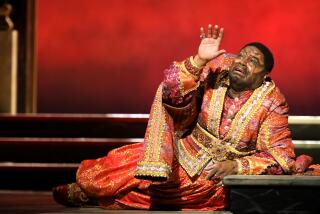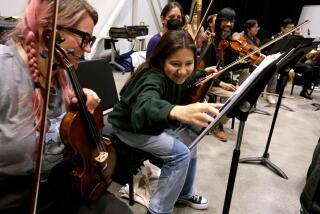1ST CONCERT AT POINT LOMA CHURCH : BAROQUE-STYLE ORGAN’S SOUND ELEGANT
- Share via
SAN DIEGO — When alluding to the organ, poets have usually lauded its noble tones or its penchant for evoking mystery and reverence. At the dedicatory recital of the new Baroque-style organ at All Souls Episcopal Church in Point Loma, organist Robert Thompson reminded his listeners of the instrument’s more playful side.
His performance of a suite of seldom-heard 17th-Century Spanish pieces, especially Jose Ximenez’s “Batalla de Sexto Tono,” called forth a host of clever sound effects--bird calls, drum imitations and battle-rousing bugle calls--that happily balanced the obligatory exercises of edifying Bach counterpoint.
The builders, the Tacoma, Wash., firm of Fritts-Richards, completed the organ last month after several months of adding its finishing touches in the church building. The organ’s traditionally styled, tall redwood case, replete with gilded filigree, is as elegant as its sound is clear and robust.
In his opening salvo, Mendelssohn’s C Minor Sonata, Thompson demonstrated that an instrument’s tonal strength can be broad and arresting without resorting to ear-splitting volume.
Thompson, a well-known recitalist and former member of the St. Olaf College music faculty, took the post of music director at All Souls Church largely because of the Fritts-Richards organ. Not surprisingly, Thompson made his best musical arguments with chorale-based selections by J.S. Bach and Dietrich Buxtehude. He used the singing quality of the pipes to state and elaborate the familiar German hymn tunes with grace and sensitivity.
Unfortunately, he relied more on velocity than on careful articulation in the closing work, Bach’s sweeping A Minor Prelude and Fugue, BWV 543. For an instrument built with such attention to detail and the possibility for re-creating historically authentic stylistic nuances, there is little point in playing it with the emotionally detached precision of a computerized facsimile.
In the opening half of the recital, Thompson attempted to show just how versatile this instrument could be, playing suites by the contemporary French organist-composers Marcel Dupre and Jean Langlais. While he made a good case for Dupre’s “Le Tombeau de Titelouze,” simply constructed movements composed around plainsong fragments, Langlais’ “Suite Breve” only demonstrated how cumbersome a Baroque organ can be without the host of modern electronic mechanical assists for instant stop-changing.
No one, of course, expects a brass band to play symphonies or an orchestra to read jazz charts with convincing results. The All Souls organ has the potential to shed new light on an amazingly large repertory of music, not just the Bach canon, but music composed a century before his birth and another century after his demise. San Diego is indeed fortunate to have such an instrument.
More to Read
The biggest entertainment stories
Get our big stories about Hollywood, film, television, music, arts, culture and more right in your inbox as soon as they publish.
You may occasionally receive promotional content from the Los Angeles Times.










